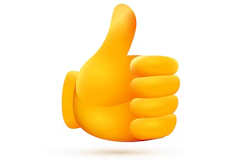About a year ago, a poster on Reddit created a viral craze with a post that asked the question “Am I not adult enough to be comfortable with the ‘thumbs up’ emoji reaction?” The resulting thread uncovered a generational divide in which many Gen Z commenters reacted negatively, saying they perceived a “thumbs up” emoji” to be rude, abrupt or passive aggressive. 
To find out if there really is a generational divide over emojis in business communications, Jarrard Phillips Cate & Hancock, a communications consulting firm that works with healthcare providers, surveyed their team, which consists of multiple generations. The survey used the following questions:
- How often do you use emojis in personal communications (e.g., texts to family/friends)?
- How often do you use emojis in professional communications (e.g., Teams notes)?
- On a scale of 1-5, How much do you like the built-in reactions in Teams?
- What are you typically trying to convey when you use the thumbs-up emoji?
- How are you most likely to interpret the thumbs up emoji when others use it?
- Please indicate your level of agreement with the following statements: The thumbs up emoji is abrupt / The thumbs up emoji is a good way to acknowledge someone / The thumbs up emoji is rude / The thumbs up emoji is a good confirmation of mutual collaboration and agreement / The heart emoji is inappropriate / The heart emoji is a positive way to convey agreement and appreciation
- What emoji do you use most often at work?
- In the past six months, have any of your work-related messages been misunderstood or misinterpreted by colleagues?
The results were divided into four age categories: age 21-29 (20 respondents), 30-39 (29 respondents), 40-49 (15 respondents) and 50+ (6 respondents). Some results were:
- When asked how often they used emojis in professional communications, most respondents indicated emoji use between “infrequently,” “once every few messages” and “once every couple of messages.”
- For most of the respondents, their use of the “thumbs up” emoji meant “acknowledgement” or “like.”
- Most of the respondents disagreed that using the “thumbs up” emoji is abrupt, although about one-third agreed and another 15% found it rude. In general, the older the respondent was, the less rude they considered it to be.
- Over half of the respondents weren’t sure if any of their professional messages had ever been misunderstood by a colleague.
So, what to make of all of this? A few communications concepts are worth considering, such as:
- Communications feeds into culture. New people in the organization bring in new perspectives.
- Message sent is not always message received.
- It’s best to assume good intent.
- Mind the trends.
How would you rate the overall communications within your organization?